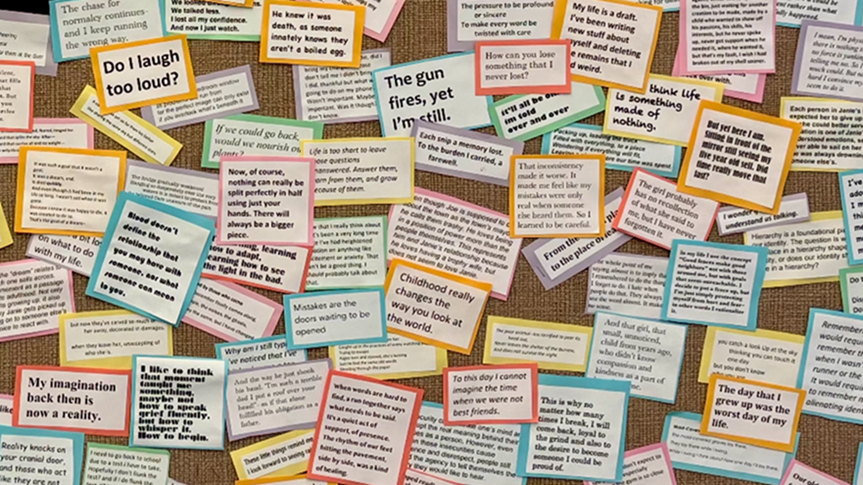
The Power of Centering Student Exemplars

Listen to the interview with Marcus Luther:
Sponsored by Solution Tree and The School Me Podcast
There is a space in my classroom that I absolutely love. It is a bulletin board tucked in the corner furthest from the door — a bulletin board that begins the school year entirely empty, aside from a little, well-worn placard that reads “Beautiful Language Wall.”

Week by week over the school year, though, sentences start appearing upon this bulletin board.
Sentences written by students.
Whenever I’m reading and responding to student writing, I keep an extra tab open to capture any writing that stands out to me — writing that I can turn around and share back with the rest of the class in a following lesson.
“Here’s something I loved about this sentence one of you wrote…”
Always anonymous, but always centered — and then that sentence shows up on the Beautiful Language Wall.
Slowly but surely, that bulletin board tucked in the corner becomes a place students gravitate to in our classroom: arriving early to class to see new arrivals on the wall, hanging back after class with peers to hunt for their own writing I had bragged about earlier in the lesson, bringing other friends not even in the class to show off how their sentence “made the wall.”
By the end of the year? That bulletin board has transformed.

This isn’t just a post about this bulletin board, though, a practice that emerged from a Kelly Gallagher summer workshop nearly a decade ago.
Rather, this is a post about what can happen in the classroom when you go beyond tossing student work up on the walls and actually center student work in the classroom itself. As much as I love the bulletin board — especially with some diligent student aides to help make updating it manageable! — the most impactful aspect occurs when I project a sentence written by a student in front of the entire class and use it as a teaching tool for the rest of their class, an inspiration of what is possible that is all the more powerful because it emerged from our own classroom.
I believe we can and should do that more in our classrooms. In this post, I will outline three different ways that I work to center student exemplars in our classroom community in a way that leverages them as tools for instruction while affirming the students who created them in a substantive, lasting way — which, I’d offer, matters more in our classrooms than ever before.
Strategy #1: Looking For and Celebrating Specific Wins
One thing that I’m a lot better at now than earlier in my career? Being more creative in how I look for wins to celebrate.
With the help of a practice from my colleague Andrea James, I’ve started really leaning into this on our feedback days. Along with sharing collective feedback in terms of strengths and growth areas, I carve out a portion of the feedback lesson to walk through specific wins from the essays that I noticed and wanted to share: best title, best opening or hook, favorite sentence, strongest closing, etc.
For each of these, I project and explain the student example and why I appreciated it — and then the top choice gets to “sign the crown.” (Context: at the beginning of the year I make a large crown out of cardstock for classroom competition winners to sign throughout the year.)

A small thing? Maybe, but not really, in my experience.
The “title crown” slide pictured above is from last year’s research unit with my sophomores. As is often the case with research, it is quite a daunting process for many students — but one of my students who had struggled for most of the year really latched onto his focus person for biographical research: Ryan Reynolds.
As you can see above, he also came up with a fantastic, creative title.
In the classroom this slide deck is animated, so each title shows up individually, one at a time. So after I had celebrated and shared about each of the three runners up, “The Ryan Behind the Reynolds” appeared front-and-center on the screen.
“YES!”
I kid you not: the student let out a genuine roar of enthusiasm.
(Then wore the crown the rest of the period once others were done signing.)
A random story, perhaps, but for me it is indicative of a classroom culture in which students have a chance to be celebrated for specific aspects of their work. They pay attention to this, too! In reading back through one of my student’s post-feedback self-reflections this year, I found this: “I’m so proud of my essay!! I got the award for best title […] I told myself I should at least try because I wanted to see if I could get it and I did!”
Too often, I think, the only form of celebration that takes place in the classroom is the grade students receive — and frequently students who don’t get the grade they were aiming for look at their work as a complete failure. Instead, by shifting to looking for and highlighting various specific components, it allows you to build confidence in your students in a genuine way while also building a culture of celebration in your classroom.
The poorly-constructed cardstock title crown full of signatures? That’s just the cherry on top.
Strategy #2: Letting Students Interact With Exemplars
Part of my own evolution with student exemplars in recent years, however, has been going one step further and taking the examples off the screen in order for them to become tangible tools for students to interact with and learn from.
One such time came after we had finished a very challenging synthesis essay with my juniors in which they had to not only arrive at an interpretation of King Lear and a 21st century poem of their choosing, but also had to design their own path and structure for the essay. (Goal: to break out of the “box” that so many essays are confined within.)
My most recent group of juniors showed out with their openings and closings in these essays — an area where previous years had struggled. So after naming and celebrating this strength whole-class, I pointed to our classroom walls:
“Now we’re going to take a look at what many of you did.”
Before the lesson, I had taken five different openings and five different closings from the essays, (A) removing names in order to keep them anonymous and (B) adding my own section at the bottom: Moves to note, a space where I added my own commentary about why the example was so effective.
Students then traveled the room looking at the work of their peers, taking notes in their own spiral notebook of what they appreciated and then leaving initials on any that really resonated with them before debriefing their findings with small groups afterwards.

Why did I love this activity so much? Three reasons:
- So often students only get to see one exemplar, and therefore get a narrow and fixed idea of what “success” looks like. In this case, though, they saw five different stellar examples of both the opening and closing of the essay they had just written — each of which had its own shape and style. (A great comparison, then, for the essays they would receive back immediately after this activity.)
- Students had a chance to discuss what stood out to them afterwards and, in particular, what resonated with them. This is really important to me in helping build a culture in our room around peer feedback that is not solely focused on criticism and points for improvement. Growth can happen in consideration of strengths and successes, too, and this activity added to that lens.
- Finally, even with the names removed, the students who wrote the exemplars knew which ones were theirs. That means they got to see peers adding their initials to their writing in celebration and that means they got to hear peers discuss appreciations of their writing within small groups.
One of my goals for every student is that they walk out of our classroom as a better writer and also a more confident writer. In past years, I often only focused on “better” and assumed the “confidence” automatically would follow, but reading student reflections in recent years frequently has thankfully reminded me that these are both cups that need to be filled.
Activities like this help a lot in that work. For students who need to take that “next step” in their writing, it presents different pathways for that next step from the examples of their classmates; for students who made that type of leap, it reaffirms that it was worth taking the risk.
Just take a look at the actual reflection of one student who got to have their writing featured on the wall for peers to affirm and learn from: “I am proud of the risks I took and my ability to insert my own voice into my essay when the thought of that terrified me at first.”
I am proud of the risks I took.
Both cups filled, right?
Strategy #3: Bring Student Exemplars to Life In Your Space
I want to share one more story from our classroom that I believe underscores the power of what leaning into exemplars can offer.
At the end of the first semester this past year, we had about twenty minutes remaining in our last class period. Students had completed their self-reflection activity with their writing portfolio and thought they had reached the finish line.
Me: “Okay everyone, before we end this semester — we have one more poem to read.”
There were some eyerolls, deservedly, from high school juniors exhausted from a week filled with semester finals, but they relented and took out their highlighters to annotate one last poem.
“We are going to read this a bit differently, though,” I say, passing out the poem to each student. “You are each going to take turns reading it aloud, one line at a time. As always, highlight what stands out to you.”
A few more eyerolls.
“Okay, 3…2…1…go.”
The first student reads the opening line. Pause, then the student sitting next to them remembers and reads the second line. Then more smoothly, the third line. The fourth, the fifth, etc., as momentum builds.
Then, like clockwork, the whispers.
“Hey, I wrote that.”
“This is from my poem.”
“I did this.”
Me: “Shhhh, keep reading.”
Finally, after every single line of the poem has been read aloud by a different student, the room erupts into conversation.
We wrote this.

A month before, students had written and shared their narrative poems with each other in what is always one of my favorite activities of the year. For me, this is when the real work begins, though: finding at least one line from each poem in the class to weave together into a “collective poem” that I can save for this final lesson of the semester. (This sounds like a lot, but it seriously is some of my favorite “puzzle work” of the year, as I get to make one for three different class periods.)
This is how we end our first semester: students reading aloud the words of each other’s poems, students hearing their own words read aloud and celebrated by peers.
As one student wrote in their end-of-year project at the end of the school year four months later: “It shows how each person, aware or not, is given a spot to be, which seems pretty meaningful to me. The poem truly became a symbol of the community we created — even in a classroom setting.”
Each person, aware or not, is given a spot to be.
We want students to become better, more confident writers in our classrooms — but we also want them to feel a sense of belonging.
Getting a chance to see their words take center stage in the classroom community?
Going back to what one student wrote in that end-of-year project: “…people can lift you and give you strength when you’re just given a place to be, each person offering a piece of their story to make a community.”
Belonging: check.
Why This Matters More Than Ever In Our Classrooms
For many teachers (*raises hand*), this current moment is rife with anxiety about what writing will actually look like in our classrooms going forward as AI collides head on with the work we are doing.
Quite honestly, I have no clue where we’re heading.
Regardless of the specific path we end up travelling as we go forward, though, the one thing I am certain of is this: It has never been more important to ask myself, How am I making writing meaningful in my classroom? How am I valuing authentic voice in writing? How am I making students feel confident in sharing their own stories?

I don’t think it has ever been more difficult to answer those questions — and that is why I feel like they need to be front-and-center in our reflections about our practices.
Part of that “front-and-center” in my classroom has been leaning on the actual writing of students and bringing it back into our actual space: to affirm with precision, to teach through example, and to bring student voice to life in new ways.
A mentor once told me that our choices are expressions of our values. When we choose to center student writing, then, it is the best way possible to express how much we value it.
Now more than ever.
You can find more from Marcus on his Substack, The Broken Copier.
Join our mailing list and get weekly tips, tools, and inspiration that will make your teaching more effective and fun. You’ll get access to our members-only library of free downloads, including 20 Ways to Cut Your Grading Time in Half, the e-booklet that has helped thousands of teachers save time on grading. Over 50,000 teachers have already joined—come on in.



